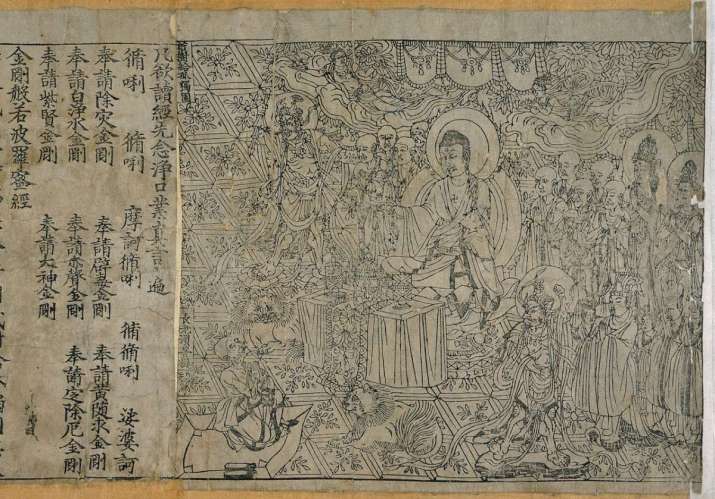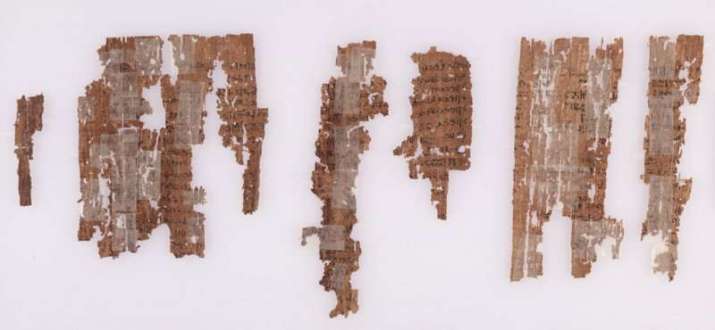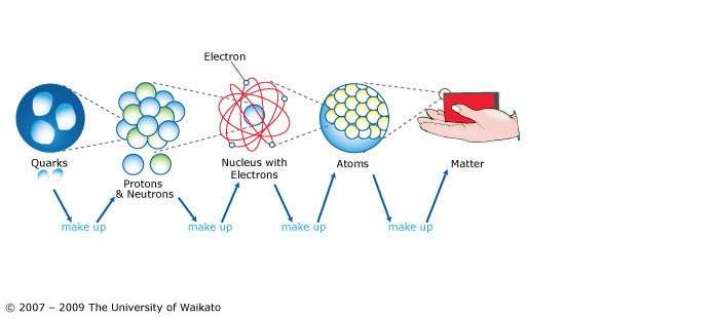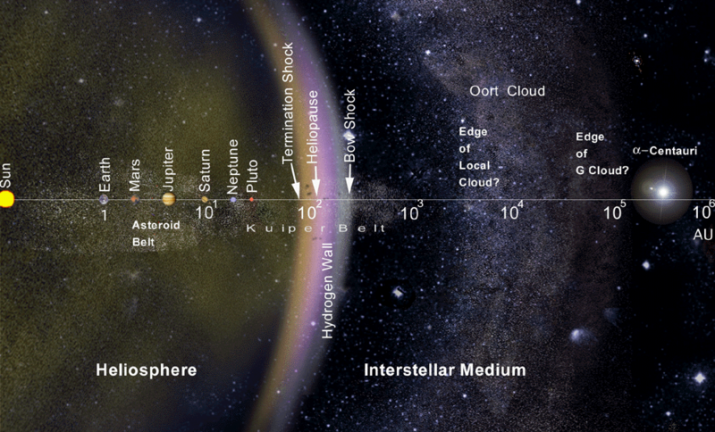FEATURES|COLUMNS|Silk Alchemy
The Iconography of Nagas, Part Five: Prajnaparamita and the Nature of Reality
 The oldest surviving printed version of the Prajnaparamita text. From wikipedia.org
The oldest surviving printed version of the Prajnaparamita text. From wikipedia.orgOnce upon a time, there was said to be a text. Not an ordinary text however. It was a text containing the secrets of nature, the cosmos, and reality itself. A text orated and divinely penned, but beyond the reading of mere mortal man. Humans were not considered ready for such revelations, so the texts were hidden deep in water and guarded by snakes, with one great serpent as the text’s main protector.
This myth echoes in various tales of wisdom and knowledge from around the world. In ancient Egypt, there was the Book of Thoth, the name given to ancient Egyptian texts said to have been written by the Egyptian god of writing and knowledge. And from Koptos, upper Egypt, hails the tale of the insatiably curious, mighty magician and scribe Neferkaptah, [ca.1504 BC] son of Amenhotep, who used magic to secure the sacred knowledge in this book from the great serpent who fiercely protected the boxed texts hidden deep in the river. The wisdom however, carried a curse of misery, including the loss of loved ones, as well as liberation from earthly existence.
And then there are the Prajnaparamita texts of Mahayana Buddhism. Texts based upon Buddha’s Second Turning of the Wheel of Dharma, that were guarded by the Naga in their watery realm until a time that humanity was deemed ready to receive them. They were eventually given to the great philosopher and teacher Nagarjuna [ca 2nd century] who, to those who would listen, he taught the Perfection of Wisdom Sutra in One Hundred Thousand Lines. In this body of scriptures, the most well known to us are the Diamond Sutra (Vajracchedikā Prajñāpāramitā) and the Heart Sutra (Prajñāpāramitāhṛdaya). This wisdom also promises liberation, but the earthly liberation from the suffering of samsara and attachment. And the curse? Well, it could be said that great wisdom can, paradoxically, feel like a heavy curse when so many seem to choose to stay in Plato’s cave.
Two ancient texts that echo a similar tale of profound knowledge hidden in water, protected by the serpent. Why the water and why the snakes? I find this intriguing as the stories seem too abstract yet curiously similar to be pure coincidence. The common thread that ties them together over geography and time, may well be disclosing something that modern science is only just catching up to.
 Fragments of the Book of Thoth. From echoesofegypt.peabody.yale.edu
Fragments of the Book of Thoth. From echoesofegypt.peabody.yale.eduWithout the nonphysical no thing can exist. So says the wisdom texts and so says quantum physics.
I am reminded of Arthur C Clarke’s famous quote “Magic's just science that we don't understand yet.” And at times, such enormous and confounding subjects such as quantum mechanics and the nature of the Prajnaparamita texts can seem as baffling to an analytical brain as magic does to a biologist. Yet a step outside of our paradigm allows us to perceive the increasingly proven phenomenon of an intangible reality. Can one be a truly spiritual person with a belief in something greater than ourselves, yet be puritanical when it comes to anything that isn’t sourced from “the” one doctrine one adheres to?
The physicist tell us that all that we can perceive of our known physical universe comprises only 4% of what they say is out there. Arguably a negligible amount in any survey. Yet, this slim percentile is everything that we call our reality, and what they have discovered so far defies any Newtonian thinking*.
Echoing the Prajnaparamita texts in every sense, science provides us with a way of examining our physicality, one layer at a time, until there is nothing inherently existent. Look at your hand. Below the skin are the layers of muscle, blood, and bones. Under the microscope, all these things become living cells busy in their own universe. Look into the cells. They are built up out of atoms, which hold protons and neutrons (in the nucleus) and electrons, spinning with a proportionally enormous space between them. To provide some sense of scale, with thanks to Nassim Haramein**: if the dome of the Vatican (approx. 42m in diameter) were the size of an atom, and if you were standing inside that dome holding a pushpin, the head of that pin would be the size of the proton inside the nucleus of that atom . . . And if you were to compare the Planck measurement (the smallest mathematical measurement determined by theoretical physicist and “discoverer” of Albert Einstein, Max Planck 1858-1947) to the size of a grain of sand, the diameter of a proton is approximately the equivalent of the distance from our sun to Alpha Centauri—40 trillion kilometers away! This means that 99.9999999% of an atom is simply space.
 The layers of our physicality. From sciencelearn.org.nz
The layers of our physicality. From sciencelearn.org.nz The distance between Earth and Alpha Centauri. From wikipedia.org
The distance between Earth and Alpha Centauri. From wikipedia.orgThen Heisenberg’s Uncertainty Principle essentially tells us that the photon, the smallest particle of light within an atom, behaves both like a particle and a wave, holding no predictable space. To make matters even more curious, at this minute subatomic scale, this “light” phenomena actually appears to acquire memory, entangles instantaneously in multiple dimensions, and may not even be our reality for more than a fraction of a moment. So everything deemed physical is in fact in a constant state of flux and possibly not even consistently in this reality.
At this subatomic level, a particle moving in a wave pattern, resembles a frequency... and the undulating serpent motif found all over the ancient world. Frequency is manifests into perceivable phenomena, as exemplified by Cymatics. So whilst this may be no surprise to any energy worker, shaman, or salt worthy spiritual practitioner, the equation busting boffins have simply been using a new language to describe these phenomena to the rational mind. But then, like so many of the greatest scientists, there’s the eventual, unavoidable realization of the profound. As Einstein stated “There are only two ways to live your life: as though nothing is a miracle, or as though everything is a miracle.”
Was it at all possible that Antediluvian ancients already held this knowledge and embodied the information in serpentine iconography?
The irony, if you will, of all this scientific exploration is the marriage of understanding between the vibrating nature of everything in our universe and the spectrum of dimensions outside of our field of mundane perception. It actually adds to the profundity of knowledge. The “extraordinary” becomes magnificently ordinary and “magic” becomes simply another science to practice. Nothing is what it seems, everything really is pure energy and very much alive. There really is no separateness, there is no inherent you, nor inherent me. Thanks to the wisdom of the ages, you knew all this already. Isn’t that awe inspiring and exciting?
Yet with great wisdom, with great power, comes the “curse of responsibility”.
*”Newtonian thinking” refers to classical/traditional thinking when it comes to the mechanics of reality. The slight irony however, is that Newton himself was highly captivated by alchemy and it was much of his occult research that gave ultimate rise to his later recognized contributions to the academic fields of science.
** Please see: Nassim Haramein - Why an atom is made of 99.9999% space? - WSIM-2015 (youtube.com)
See more
What Is a Photon in Physics? (ThoughtCo.)
Heisenberg's Uncertainty Principle (LibreTexts)
Quantum entanglement between a single photon and a trillion rubidium atoms (Phys.org)
Multidimensional tomography of an entangled photon-pair source using stimulated emission (Illinois Experts)
A Jewel at the Heart of Quantum Physics (Quantamagazine)
Becker, Wolfgang. 2015. “Fluorescence lifetime imaging by multi-dimensional time correlated single photon counting.” Medical Photonics. 27: 41-61.
Related features from Buddhistdoor Global














